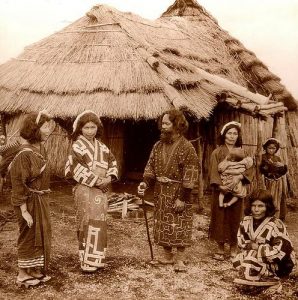The Wandering Witch Chases a Golden Kamuy

Welcome, all, again. This new viewing season seems to have gotten off to a slow start, but I waited, and good things arrived! One of the best so far is Golden Kamuy (kamuy meaning spiritual being), a shining example of well-written historical fiction. Our tale is set in the harsh landscape of early 1900s Hokkaido, a time during which the Japanese were colonizing the island and often ruthlessly subjugating the indigenous Ainu people. Sugimoto, an ex-soldier-turned-miner, hears a rumor of treasure plundered from the Ainu but then hidden before the perpetrators were arrested. Desperate to secure money to pay for medical procedures to save the eyesight of his dead comrade’s wife, Sugimoto decides to pursue the treasure. Unfortunately for him, gathering clues to its whereabouts proves somewhat complicated–the biggest complication of all being also the smallest, a young Ainu girl named Asirpa.

Our initial protagonist is Saichi Sugimoto, a veteran of the Russo-Japanese War who served in the Japanese Imperial Army’s 1st Division at the siege of Port Arthur, the war’s most protracted land battle. This siege lasted five grueling months, and combined casualties for both sides are usually numbered at roughly 80,000-100,000 men. The Japanese eventually prevailed, with the Russians surrendering Port Arthur in the first week of January, 1905. Sugimoto, having survived this slaughterhouse, finds new purpose in life with a battlefield promise made to his dying friend–obtain the money necessary to send that friend’s wife to the United States for treatment to stop or even reverse her encroaching blindness. To this end (and with his enlistment having expired), Sugimoto becomes a late arrival for the Hokkaido Gold Rush, which began in 1898. But having arrived years late, he just isn’t doing too well. In fact, things seem rather dismal until a drunk entertains him with a tale of gold stolen from the local Ainu–who were murdered to obtain it–and then hidden as Japanese troops closed in on the killers. The drunk tells Sugimoto that the one jailed perpetrator of this crime was deliberately crippled by his jailers to prevent his escape, but also in hopes of convincing him to reveal the location of the gold. Instead, he tattoos each of his fellow prisoners with different clues about the hiding place, urging them to escape and find his friends who evaded capture. He promises that his friends will reward them for their help in locating the gold, but things instead fall apart when they actually do escape, with some hunting the others.

As Sugimoto begins to realize the significance of these details, he ends up confronting a very large, hungry brown bear which has decided to feast upon the talkative drunk. Sugimoto is not especially adept at fighting bears, and receives welcome aid upon the sudden arrival of a feisty Ainu girl named Asirpa. Being native to the land, she is much more skilled at surviving there, and manages to guide Sugimoto through two back-to-back bear encounters. Moreover, it turns out that her father was one of the Ainu murdered when their gold was plundered. After speaking with Sugimoto for a while, Asirpa decides to help him track down the escaped prisoners and find the gold, which he in turn promises to split with her. This, despite officially sanctioned prejudice against the Ainu by the Japanese (and Russians). These two are playing with fire.

Fire, you say? I do. The plight of the Ainu in the latter 19th and early 20th centuries resembled that currently suffered by the Kurds–both peoples inhabit[ed] a geographical area spread across national borders, while being held suspect and oppressed by those different nations for possessing their own unique culture. Both Japan and Russia refused to officially recognize the Ainu as indigenous people, thus preventing them from claiming rights specific to such peoples (e.g., hunting and fishing rights). Then, to preclude them from pursuing such recognition, Japan in 1899 declared all Ainu to be Japanese citizens. It was not until 2008 that Japan recognized the Ainu as indigenous; Russia has yet to do so. And although there had been a Japanese presence on the southern end of Hokkaido for centuries, it was not until 1868 that the island was officially annexed, renamed from Ezo (foreigner) to Hokkaido, and became the subject of active colonization. Until that time, the Japanese governance was mainly in name, with local Ainu tribal rule sufficing for most of the island. That is the weighted backdrop of our story.
But what a story! And what a glorious telling! Tight storylines, detailed artwork, and fluid animation combine to make Golden Kamuy a truly impressive anime. This show might be story-driven, but it just oozes with incredible characterization. Are Sugimoto and Asirpa believable? Should they be? This show celebrates the refusal to be just a microcosm of the society that engenders you. Kudos!
















[…] 1, set in frigid Hokkaido, instantly reminded me of Golden Kamuy. And episode 2 was the mecha and idols episode. (Too many choices for either […]